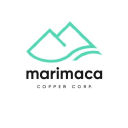High-Grade Intercepts at Pampa Medina Set Stage for Major PEA Update by Year End

Marimaca hits 50m at 2% Cu at Pampa Medina; 900m stepouts confirm extensive sedimentary system. 200m+ thick horizon suggests open-pit potential. Standalone PEA targeted Dec 2025.
- Drill results revealed nearly 50m at 2% copper in a broader 160m zone at 1%, representing a material extension to the oxide envelope at Pampa Medina with grades higher than current block model interpretations.
- Aggressive 900-meter stepout holes to the south hit the same mineralised sedimentary horizon with zones of 20-40m at 1.5% copper, confirming the regional extent of this sedimentary-hosted copper system.
- Two-thirds focused on aggressive 300-meter spacing stepouts to define deposit limits; one-third on tighter infill drilling to establish grade and thickness continuity before targeting an inferred resource.
- Company targeting a standalone Preliminary Economic Assessment (PEA) for Pampa Medina by December 2025, with oxide resource now expected to deliver significantly more than the initially projected 20,000 tons of incremental annual copper production.
- Previously considered purely underground, new geological review suggests the sedimentary horizon averages 200+ meters thickness with consistent mineralization, opening possibilities for large-tonnage open-pit development alongside high-grade zones.
Marimaca Copper is making significant progress at its Pampa Medina project in northern Chile, with recent drill results confirming the company's geological thesis while revealing both higher-grade oxide mineralization and extensive sulfide potential across a large sedimentary basin. CEO Hayden Locke provided a comprehensive update on the project's development trajectory, exploration strategy, and evolving understanding of what could become a substantial copper system.
Material Oxide Extension with Superior Grades
The latest drill results have delivered compelling oxide intercepts that exceed current resource expectations. A standout intersection of nearly 50 meters at 2% copper within a broader 160-meter zone grading 1% copper represents a material extension to the oxide envelope. According to Locke, this discovery is "certainly higher grade than what our current interpretation of the block model is," signaling positive upside to the oxide resource that Marimaca initially acquired as part of the Pampa Medina package.
The oxide discovery carries particular significance for Marimaca's near-term production profile. The company originally acquired Pampa Medina expecting it would "add 20,000 tons of additional incremental copper for at least 10 years at Mine Life" to complement its flagship Marimaca project. However, Locke now indicates the company is "forming a view that it's going to be significantly more than that," with upside apparent both in the existing resource and through extensional drilling.
Aggressive Stepout Strategy Confirms Regional Scale
Marimaca is executing an unusually aggressive exploration approach with stepout holes spaced at significant distances to rapidly define the system's extent. Drill holes stepped out 900 meters to the south successfully intersected the same mineralised sedimentary horizon, with zones ranging from 20 to nearly 40 meters at 1.5% copper. These results align with Locke's stated threshold for ore-grade material:
"I'm looking for things that are 20m true thickness at north of 1% to be ore grade in an eventual mine."
The successful southern stepouts came as a pleasant surprise to the technical team, hitting "thicker higher grade zones than we were expecting in that area where we thought it was going to be thinning," according to Locke. This discovery has prompted the company to continue drilling to the south in addition to its primary focus areas to the west and north.
30,000-Meter Program Balances Extension and Definition
Marimaca's current 30,000-meter drill program reflects a two-phase strategy designed to balance rapid deposit definition with sufficient data density for resource estimation. Approximately 20,000 meters (two-thirds of the program) will focus on continued stepout drilling at 300-meter spacings both westward and on north-south fences. This aggressive spacing reflects confidence in the geological model for sedimentary-hosted copper deposits, which "tend to be laterally and regionally quite extensive," as Locke explained.
The remaining 10,000 meters will focus on tighter-spaced drilling to "join the dots between these high-grade zones and see if there's geological continuities on a slightly tighter spacing to just give us some more confidence in the overarching thesis." This infill work aims to establish grade and thickness continuity between fence lines before the company embarks on a more comprehensive program targeting an inferred resource on 100-by-100-meter spacing.
The exploration approach is informed by geophysical surveys, particularly an Audio-Magnetotelluric (AMT) survey measuring resistivity. Locke reports "a fairly good correlation between the drilling that we're doing with the AMT resistivity low and then sulfide intersections in the sedimentary horizon," providing confidence in the targeting methodology even as some zones show elevated pyrite that creates similar geophysical signatures without contributing economic value.
Interview with Hayden Locke, CEO of Marimaca Copper
Geological Complexity and Post-Mineral Structures
The Pampa Medina deposit exhibits structural complexity related to post-mineral faulting and dyking that occurred after copper mineralization was emplaced. While these features create discontinuities in the mineralization, Locke emphasised that
"all of those discontinuities in the mineralization are postmineral, which means they occurred after the deposit was emplaced. [Importantly, drilling continues to encounter] good grades of thicknesses on either side of it, which indicates again that there is continuity where those late stage postmineral dikes and faults don't exist."
The company has also revised its understanding of mineralization within the dykes themselves. Previously interpreted as completely barren, detailed review has revealed that "the dikes aren't completely barren. There is definitely some mineralization going into those dikes." While not hosting the super high grades seen in the sedimentary horizon, this mineralization "all adds tons in the end" and improves the overall resource picture.
The post-mineral faulting has created variable oxide depths across the deposit, with sulfide intersections occurring at depths ranging from 200-300 meters to 500-600 meters downhole depending on fault block geometry. Understanding this structural architecture will become increasingly important as drill density increases.
Evolving Deposit Model: Underground to Potential Open Pit
Perhaps the most significant shift in Marimaca's thinking concerns the fundamental development approach for Pampa Medina's sulfide resource. Locke candidly acknowledged revising his initial assumptions:
"I have always thought that this was 100% an underground opportunity... What we're doing now is going back and reviewing these drill holes"
Geological review has revealed that the mineralised sedimentary horizon "is on average north of 200m thick and is fairly consistently mineralised," suggesting potential for a large-tonnage open-pit scenario rather than selective underground mining.
The revised geological modeling has also identified significant lower-grade material in a halo around high-grade cores that was previously excluded from consideration. This material could contribute substantial tonnage in an open-pit scenario, fundamentally changing the project's scale and economics.
Metallurgical Characteristics and Processing Strategy
The oxide mineralization at Pampa Medina presents favourable metallurgical characteristics that align well with Marimaca's existing technical knowledge. The copper species is "dominantly atacamite" with no chrysocolla, the more challenging species present at the main Marimaca deposit. While the different host rock affects acid consumption parameters, Marimaca has access to extensive historical technical data including "acid solubility, some cyanide soluble data and analytical acid consumption" from previous drill campaigns.
The company is currently conducting column leach tests for the Pampa Medina oxides, though Locke expressed confidence that existing knowledge provides "a reasonably good handle already on the direction of travel" for metallurgical performance. Placeholder assumptions in the economic analysis are considered "reasonable, valid, maybe slightly conservative."
Standalone PEA Target by Year-End
Marimaca is well advanced on a standalone Preliminary Economic Assessment (PEA) for Pampa Medina, targeting release before December 2025. The decision to pursue a standalone study rather than integrating Pampa Medina into the existing Marimaca Definitive Feasibility Study (DFS) reflects regulatory and reporting considerations. As Locke explained,
"assuming an integration into the Marimaca DFS study would require us to re-release our DFS and there's just a whole lot of complications of how we report that."
The standalone PEA will model a scenario where Pampa Medina operates independently with its own crushing, leaching, and cathode production infrastructure.This approach provides flexibility while establishing a conservative baseline for project economics.
For the oxide resource specifically, the development timeline and integration pathway appear relatively clear. The oxides are viewed as a "satellite" to the main Marimaca operation, with processing methodology well understood. The sulfide resource, by contrast, represents "a very different beast" requiring different processing approaches and likely developing over a five-year timeframe as the company continues drilling and evaluating this potentially substantial opportunity.
The Investment Thesis for Marimaca Copper
- High-Grade Oxide Extension: Recent intercepts of 50m at 2% copper (within 160m at 1%) exceed current resource models, with oxide resource now expected to deliver significantly more than the initially projected 20,000 tpa incremental copper production over an extended mine life.
- Large-Scale Sulfide Discovery: Aggressive stepout drilling successfully hit mineralised horizons 900m from known zones with 20-40m at 1.5% copper, confirming regional extent of a sedimentary-hosted copper system that appears extensive across multiple kilometers.
- Deposit Optionality: Evolving geological understanding reveals 200m+ thick mineralised sedimentary horizon with consistent grades, transitioning the conceptual development model from underground-only to potential large-tonnage open-pit scenario, fundamentally expanding scale and economic potential.
- Near-Term Catalysts: Standalone PEA targeted for December 2025 release will provide initial economic framework for Pampa Medina oxides; ongoing 30,000m drill program with monthly result releases through year-end and into 2026 expected to continue defining deposit scale.
- Infrastructure Synergies: Pampa Medina located adjacent to permitted Marimaca flagship project, enabling significant capital cost synergies through shared processing infrastructure while standalone PEA provides conservative baseline economics.
- Favorable Metallurgy: Oxide copper species (atacamite) well-understood and amenable to heap leach processing; extensive historical technical data and ongoing column tests de-risking processing approach.
- Exploration Upside: AMT geophysical surveys showing strong correlation with drilling results; systematic 300m-spaced fencing approach efficiently defining deposit limits before comprehensive infill program targets inferred resource on 100x100m spacing.
- Multiple Development Horizons: Oxide satellite feeding into near-term Marimaca production (2-3 year timeline) distinct from sulfide resource requiring 5+ years of drilling and evaluation, providing staged development optionality and extended exploration value creation.
Macro Thematic Analysis:
Chile's sedimentary-hosted copper deposits represent an underexplored geological setting compared to the country's prolific porphyry systems, yet offer potential for extensive, high-grade mineralization in laterally continuous horizons. Marimaca's Pampa Medina discovery exemplifies this opportunity, with drill results confirming that "this sedimentary horizon which is mineralised is very extensive" across a basin spanning four to five kilometers east-west and multiple kilometers north-south. The favorable characteristics include consistent 20m+ true thickness zones at 1%+ copper grades that meet ore-grade thresholds, atacamite oxide mineralization amenable to heap leaching, and sedimentary stratigraphy that enables predictive targeting.
As Locke noted, sedimentary-hosted systems "tend to be laterally and regionally quite extensive," allowing aggressive exploration approaches to rapidly define scale. With Chile maintaining its position as the world's top copper producer amid tightening global supply and energy transition demand, discoveries that leverage infrastructure adjacency while accessing different geological settings provide compelling risk-reward profiles for investors seeking exposure to copper's structural demand drivers.
"We're now confident that this sedimentary horizon which is mineralised is very extensive and now we want to move towards defining what the grade and thickness continuity is."
TL;DR
Marimaca Copper's Pampa Medina project is delivering high-grade drill results that confirm an extensive sedimentary-hosted copper system, with recent intercepts of 50m at 2% copper extending the oxide envelope and 900m stepouts hitting 20-40m zones at 1.5% copper. The company is executing an aggressive 30,000m drill program to define deposit limits while targeting a standalone PEA by December 2025. Evolving geological understanding suggests the 200m+ thick mineralised horizon could support large-tonnage open-pit development rather than underground-only mining, fundamentally expanding scale potential alongside near-term oxide satellite opportunities that now exceed initial 20,000 tpa production projections.
FAQs (AI Generated)
Analyst's Notes




Subscribe to Our Channel
Stay Informed























